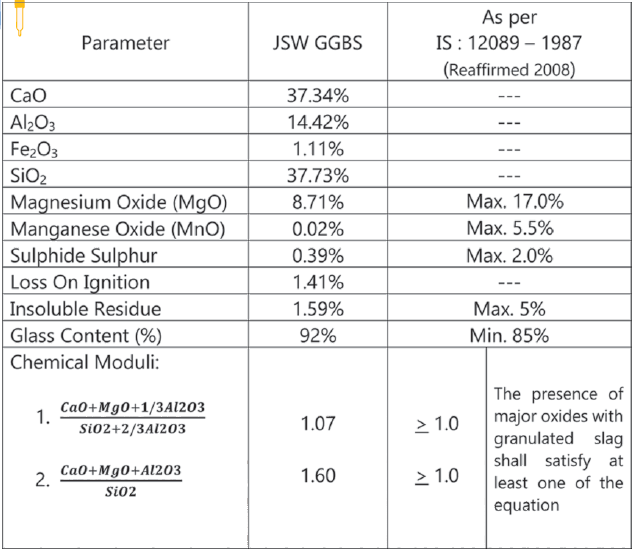Granulated Blast Furnace Slag is the by-product obtained in the manufacture of pig Iron in blast furnaces at around 1400 to 1500 C in the molten form. The slag is obtained by rapidly chilling the molten ash from the furnace by means of chilled water and is ground about 400 m2/kg of fineness by using state of the art grinding mill to make GGBS. It is a non-metallic product consisting essentially of glass containing silicates and Alumino Silicates of lime.
Superior Final Strength
Concrete with GGBS has higher proportion of the strength enhancing Calcium Silicate Hydrates (C-S-H) than concrete made with Portland Cement only. Concrete made with GGBS continues to gain strength and double its 28 day comprehensive strength over a period of time.
Enhanced Durability
- Alkalis are consumed in the concrete with GGBS during hydration process thus reducing Alkali Silica Reaction (ASR)
- Improved resistance to Sulphate attack due to reduction of Ca(OH)2 and lower C3A content
- Due to reduced diffusion of Chloride ions, resistance to corrosion is improved
Engineering Properties
- The total shrinkage of concrete containing GGBS was lower than 100% Portland cement
- Concrete made with GGBS generally exhibit higher flexural strength for a given level of compressive strength
- Structural stiffness can be enhanced and load deflections minimized.
Applications of GGBS
GGBS is used to make durable concrete structures in combination with Ordinary Portland Cement and other pozzolanic materials. To improve the durability of structures, usage of GGBS along with OPC in concrete is recommended in BS 6699:1986, ASTM C989:1982, IS 456:2000 and GGBS to OPC in the range of 25-70% shall be added to manufacture Portland Slag Cement as per IS 455:1989.
GGBS Advantages
- Reduction in heat of hydration and minimization of Thermal cracks.
- Permeability and surplus lime liberated during the hydration of Portland cement are the root causes for deleterious effect on the concrete.
- Absorption of surplus lime released out of OPC to form in to secondary hydrated mineralogy.
- Pore refinement and grain refinement due to the secondary hydrated mineralogy, thus contributing for impearability and enrichment of Transition zones.
- Reduced requirement of cement for same strength thus reduces the cost of concrete.
- IS 456:2000 recommends addition of more than 50% GGBS where Chloride is encountered along with Sulphates in place of SRC.

